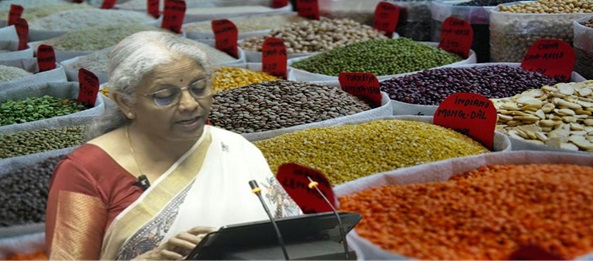Why in the NEWS?
- A mission of Rs 1,000 crore has been brought in the Union Budget 2025 to achieve self-sufficiency in pulses.

Key Points:
- Finance Minister Nirmala Sitharaman has announced the launch of a six-year 'Self-Reliance Mission in Pulses'.
- In this, special focus will be given to tur/arhar, urad and lentil.
What will you read next in this topic?
- Rs 1,000 crore mission in Budget 2025 for self-sufficiency in pulses:
- Role of NAFED and NCCF:
- Imports of pulses rising:
- Previous efforts towards self-sufficiency:
- Agricultural success of chickpea and moong:
- Development of new varieties:
- Difficulty in cultivation of tur/arhar:
- Efforts to increase production:
- Challenges and Solutions for Self-sufficiency in Tur/Arhar
Rs 1,000 crore mission in Budget 2025 for self-sufficiency in pulses:
- The Union Budget 2025-26 has announced an Rs 1,000 crore mission to achieve self-sufficiency in pulses.
- The move presents a significant opportunity for India, especially when the country’s pulses imports are set to touch new heights.
- Its main objective is to provide Minimum Support Price (MSP) based procurement and post-harvest storage solutions in respect of three major pulse crops.
Role of NAFED and NCCF:
- Under this scheme, a process will be initiated for registration of farmers with NAFED (National Agricultural Cooperative Marketing Federation of India) and NCCF (National Cooperative Consumers Federation of India).
- Farmers registering with these agencies will be able to sell their produce at the maximum price under MSP.
- The aim is to provide farmers an opportunity to sell their produce at a fair price, so as to increase their income.
Imports of pulses rising:

- Significantly, this comes even as India’s pulses imports during April-November 2024 were valued at $3.28 billion, 56.6% higher than the $2.09 billion for the corresponding period of 2023.
- This is leading to increasing import pressure, making the need to achieve self-sufficiency even more important.
- If this rate continues, imports could reach $5.9 billion in 2024-25.

Previous efforts towards self-sufficiency:
- India had seen a rise in the import of pulses between 2013-14 and 2016-17.
- However, imports decreased from 2018-19 and steps were taken towards self-sufficiency.
- Imports of peas and chickpeas declined in 2018-19, and imports increased again in 2023-24.
Agricultural success of chickpea and moong:
- Mainly chickpea and moong crops are playing an important role in India's pulses production.
- The production of chickpea has increased from 95.26 lakh tonnes in 2013-14 to 122.67 lakh tonnes in 2022-23, while the production of moong crop has also increased.
Development of new varieties:
- New varieties have been developed in chickpea and moong, which give production in less time.
- New varieties of gram mature in 100-120 days, while moong varieties mature in 50-75 days.
- These varieties have given farmers the opportunity to take more crops.
Difficulty in cultivation of tur/arhar:
- There are still some problems in the cultivation of tur/arhar.
- The traditional tur crop used to mature in 250-270 days and gave low yield.
- Now new varieties have come, which yield 15-16 quintals per hectare, but it is still low.
- Cultivation of tur/arhar is mainly limited to Maharashtra and North Karnataka, where rain-fed farming is predominant.
Efforts to increase production:
- The government has taken concrete steps to promote MSP based procurement of gram and moong.
- The production of gram and moong has been encouraged through MSP procurement during 2022-23 and 2023-24.
- The Ministry of Agriculture and other related agencies are planning to use new agricultural technologies to increase the production of pulses.
- These technologies will be used to make the production process more efficient and transparent.
Challenges and Solutions for Self-sufficiency in Tur/Arhar
- Achieving self-sufficiency in tur/arhar cultivation in India is an important objective, but there are some major challenges for this:
Development of hybrid varieties:
- Traditional tur/arhar varieties mature in 250-270 days and yield 20 quintals per hectare.
- Self-sufficiency requires hybrid varieties that mature in 140-150 days, yield 18-20 quintals per hectare and are suitable for mechanical harvesting.
- This will increase the yield and also save farmers' time.
Policy ambiguity:
- The government wants farmers to grow leguminous crops, but tur/arhar prices often go below the MSP.
- For example, in Maharashtra and Karnataka, tur/arhar is selling at an average of Rs 7,300-7,400 per quintal, while its MSP is Rs 7,550.
- In addition, import of tur/pigeon pea is exempted from duty free, thereby competing with domestic production.
Steps towards self-sufficiency:
- India needs to develop hybrid varieties, policy reforms and changes in import policy to become self-sufficient in tur/pigeon pea.
- The government has to adopt a strong policy to ensure compliance with MSP and promote domestic production.
|
Q. What kind of exemption is given on the import of Tuar/Arhar in India?
(a) 50% import duty
(b) 20% import duty
(c) Duty free import
(d) 10% import duty
|



